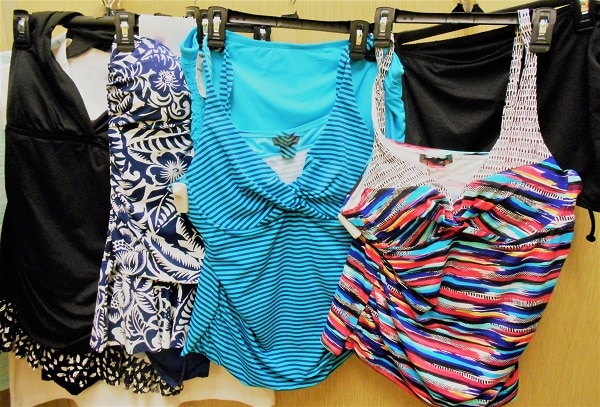Content Menu
● Understanding Swimsuit Fabrics
● The Dryer Dilemma
● Proper Drying Techniques for Swimwear
● Washing Your Swimsuit: Best Practices
● Dealing with Specific Swimwear Issues
● Storing Your Swimwear
● Extending the Life of Your Swimwear
● Environmental Considerations
● Conclusion
As summer approaches and beach days become more frequent, many of us find ourselves reaching for our favorite swimsuits. Whether you're a seasoned swimmer or someone who enjoys lounging by the pool, proper care of your swimwear is essential to ensure its longevity and maintain its appearance. One question that often arises in the realm of swimsuit care is: "Can swimsuits go in the dryer?" This comprehensive guide will delve into the intricacies of swimsuit care, with a particular focus on drying methods, to help you keep your beachwear in top condition for seasons to come.

Understanding Swimsuit Fabrics
Before we address the drying question, it's crucial to understand the materials used in swimwear. Most modern swimsuits are made from a blend of synthetic fibers, such as:
1. Nylon: Known for its durability and quick-drying properties.
2. Spandex (also called Lycra or Elastane): Provides stretch and shape retention.
3. Polyester: Offers chlorine resistance and color fastness.
4. Microfiber: A soft, lightweight fabric that dries quickly.
These materials are chosen for their ability to withstand exposure to chlorine, saltwater, and sun while maintaining their shape and color. However, these same properties that make them ideal for swimwear also make them sensitive to heat and certain care methods.
The Dryer Dilemma
Now, let's address the burning question: Can swimsuits go in the dryer? The short and emphatic answer is no. Putting your swimsuit in the dryer is one of the quickest ways to damage it. Here's why:
1. Heat Damage: The high temperatures in a dryer can break down the elastic fibers in your swimsuit, causing it to lose its shape and elasticity. This is particularly true for suits with spandex or Lycra content.
2. Fabric Degradation: The tumbling action of the dryer, combined with heat, can cause excessive wear on the delicate fabrics, leading to pilling, thinning, or even tearing of the material.
3. Color Fading: Heat can accelerate color fading, especially in vibrant or dark-colored swimsuits.
4. Shrinkage: Some swimsuit materials may shrink when exposed to high heat, altering the fit of your garment.
5. Damage to Embellishments: Sequins, beads, or other decorative elements on swimsuits can melt, fall off, or become damaged in the dryer.

Proper Drying Techniques for Swimwear
Since the dryer is off-limits, what's the best way to dry your swimsuit? Here are some recommended methods:
1. Gentle Squeeze: After rinsing or washing your swimsuit, gently squeeze out excess water. Avoid wringing or twisting the fabric, as this can stretch and damage the fibers.
2. Towel Roll: Lay your swimsuit flat on a clean, dry towel. Roll the towel with the swimsuit inside, pressing gently to absorb excess moisture. This method is particularly effective for removing water without stressing the fabric.
3. Air Drying: The best way to dry your swimsuit is to let it air dry naturally. Here are some tips for effective air drying:
◆ Hang the suit in a well-ventilated area, away from direct sunlight. UV rays can fade colors and break down fibers over time.
◆ Use a plastic hanger or lay the suit flat on a drying rack. Avoid metal hangers, which can rust and stain the fabric.
◆ If hanging, drape the suit over the hanger rather than using clothespins, which can leave marks or stretch the fabric.
◆ For suits with molded cups, lay them flat to dry to maintain their shape.
4. Avoid Heat Sources: Keep your swimsuit away from radiators, heated towel rails, or other heat sources while drying.
5. Patience is Key: Allow your swimsuit to dry completely before wearing or storing it. This can take anywhere from a few hours to overnight, depending on the fabric and humidity levels.

Washing Your Swimsuit: Best Practices
Proper drying starts with proper washing. Here are some tips to ensure you're cleaning your swimsuit correctly:
1. Rinse Immediately: After each use, rinse your swimsuit in cool, clean water to remove chlorine, salt, sand, and sunscreen. This simple step can significantly extend the life of your swimwear.
2. Hand Wash: Whenever possible, hand wash your swimsuit. Fill a sink or basin with cool water and add a small amount of mild, swimwear-specific detergent or gentle hand soap.
3. Gentle Agitation: Swish the suit gently in the soapy water for a few minutes. Avoid scrubbing or twisting the fabric.
4. Rinse Thoroughly: Rinse the swimsuit in cool water until all soap residue is gone. Soap left in the fabric can lead to irritation and damage over time.
5. Avoid Harsh Chemicals: Never use bleach, fabric softener, or other harsh chemicals on your swimsuit. These can break down the fibers and affect the suit's performance.
6. Machine Washing (If Necessary): If you must use a washing machine, choose a gentle cycle with cool water. Place the swimsuit in a mesh laundry bag to protect it from excessive agitation.
7. Frequency: Avoid washing your swimsuit after every wear unless necessary. Over-washing can lead to premature wear and tear.

Dealing with Specific Swimwear Issues
Chlorine Damage: Chlorine can be particularly harsh on swimsuit fabrics. If you frequently swim in chlorinated pools, look for swimwear labeled as chlorine-resistant. After swimming, rinse your suit thoroughly in cool water to remove as much chlorine as possible.
1. Saltwater Care: Saltwater can leave mineral deposits on your swimsuit, leading to discoloration and fabric breakdown. Always rinse your suit in fresh water after ocean swimming.
2. Sunscreen Stains: Sunscreen can leave oily stains on swimwear. To prevent this, allow sunscreen to absorb into your skin before putting on your swimsuit. For existing stains, pre-treat with a gentle stain remover before washing.
3. Fading: To prevent color fading, avoid prolonged exposure to sunlight when drying your swimsuit. If possible, dry colored suits in the shade or indoors.
4. Stretching: If your swimsuit becomes stretched out, try soaking it in cool water with a bit of white vinegar for about 30 minutes. This can help the fibers regain some of their elasticity.

Storing Your Swimwear
Proper storage is just as important as proper washing and drying. Here are some tips for storing your swimsuits:
1. Ensure Complete Dryness: Never store a damp swimsuit, as this can lead to mildew and unpleasant odors.
2. Avoid Folding: If possible, lay your swimsuits flat or hang them to prevent creases and maintain their shape.
3. Use Breathable Storage: Store swimwear in a cool, dry place with good air circulation. Avoid plastic bags, which can trap moisture.
4. Separate Light and Dark Colors: When storing multiple swimsuits, keep light and dark colors separate to prevent color transfer.
5. Rotate Usage: If you have multiple swimsuits, rotate their usage to give each suit time to fully recover its shape between wears.
6. Seasonal Storage: For long-term storage during off-seasons, ensure suits are clean and completely dry. Consider using acid-free tissue paper to stuff molded cups and prevent creasing.
Extending the Life of Your Swimwear
By following these care instructions, you can significantly extend the life of your swimwear:
1. Alternate Suits: If possible, have multiple swimsuits and alternate their use. This gives each suit time to fully dry and recover its shape between wears.
2. Shower Before Swimming: Rinsing off before entering the pool or ocean can help your suit absorb less chlorine or saltwater.
3. Sit on a Towel: When lounging on rough surfaces like pool decks or sand, sit on a towel to prevent snags and pilling on your swimsuit.
4. Avoid Hot Tubs: The high temperatures and chemicals in hot tubs can be particularly damaging to swimwear. If possible, have a separate, dedicated suit for hot tub use.
5. Handle with Care: Be gentle when putting on and taking off your swimsuit, especially if it has delicate straps or embellishments.
6. Invest in Quality: While it may be tempting to opt for cheaper swimwear, investing in higher-quality suits made with durable fabrics can save you money in the long run.
Environmental Considerations
As we become more environmentally conscious, it's worth considering the impact of our swimwear care routines:
1. Water Conservation: When hand washing or rinsing swimsuits, be mindful of water usage. Consider using a bucket or basin rather than running water continuously.
2. Eco-Friendly Detergents: Look for biodegradable, phosphate-free detergents specifically designed for delicate fabrics and swimwear.
3. Sustainable Swimwear: Consider purchasing swimsuits made from recycled materials or sustainable fabrics. Many brands now offer eco-friendly options that are both stylish and environmentally responsible.
4. Repair and Upcycle: Instead of discarding swimsuits at the first sign of wear, consider repairing minor damage. For suits that are beyond repair, look into textile recycling programs or creative upcycling projects.
Conclusion
In conclusion, while it may be tempting to toss your swimsuit in the dryer for quick drying, this practice can significantly shorten the lifespan of your beachwear. By understanding the delicate nature of swimsuit fabrics and following proper care instructions – including gentle washing, air drying, and appropriate storage – you can keep your swimwear looking great for many seasons to come.
Remember, the key to swimsuit longevity lies in gentle handling, proper cleaning, and patience when it comes to drying. By avoiding the dryer and opting for air drying methods, you're not only preserving the fit, color, and elasticity of your swimsuit but also potentially reducing energy consumption and extending the overall life of your garment.
As you prepare for your next beach day or pool party, take a moment to consider how you'll care for your swimwear afterward. With these tips in mind, you'll be well-equipped to maintain your swimsuit collection, ensuring that each piece remains a stylish and functional part of your summer wardrobe for years to come. So, enjoy the water, soak up the sun, and rest easy knowing that your favorite swimsuit will be ready for your next aquatic adventure, thanks to your newfound expertise in swimwear care.






































